
In 1951, John Wayne produced The Bullfighter and the Lady, giving director Budd Boetticher his big break. They shot it in the federal district in Mexico City and in a small settlement then called Xayai. More importantly, the John Wayne Production got permission to shoot in the Plaza de Toros México, the world’s largest bullring, then just four years old. Boetticher made good use of the statues dedicated to bullfighting, lining the square at Augusto Rodin 130.

Now under his own Batjac Flag, John Wayne produced Hondo in Camargo, in the State of Chihuahua, Mexico, in May and August 1953. He himself said about Camargo that it was „a one-horse border town. “
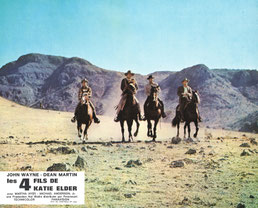
In 1965, John Wayne made the city of Durango in the Valley of Guadiana in northern Mexico his base of operations for a number of westerns to come. On January 4, 1965, he got up from his hospital bed after his cancer operation and left for Durango to do The Sons of Katie Elder. The cast usually stayed at the Campo Mexico Courts Hotel at Avenida 20 de Noviembre.
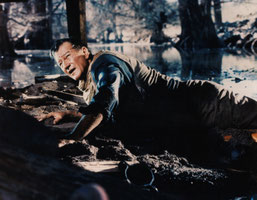
They used the river near the triple waterfall called Cascada El Saltito, reached on Route 45 to the east of Durango, a location they came to use in almost all of the subsequent Mexico westerns. The monumental trees in the area, the large-sized Montezuma cypress, added their beauty to the scenes.

On the day they shot how the Elder brothers drag Wayne into the icy mountain stream, he blacked out, but he quickly came to. This incident was subsequently often mistaken for the scene of the assault on the bridge (same river, different location).
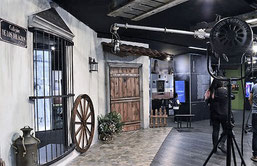
Interiors were shot inside the Estudio Churubusco, the studios in Mexico City (still in operation, on the Ciudad de México).
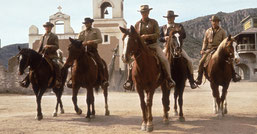
According to the Durango state tourism department, Chupaderos, a dust-blown village on Mexico’s central plateau, lured nearly fifty American film crews south of the border. The Katie Elder production started that tradition when the chalky streets portrayed the town of Sweetwater. Pretty soon, as many as three movies a year were being shot in the western town.

They soon enlarged the Chupaderos western town for The War Wagon. Art director Alfred Sweeney added another twenty buildings. Some of the houses featured detailed interiors so they could shoot people actually get in and out.

Director Burt Kennedy had noticed the Sierra de Órganos National Park in the Raoul Walsh western The Tall Men. The Los Organos park is located in the northwest corner of Sombrerete. To shoot the War Wagon sequences there, they built an airport to fly cast and a crew up from Durango in a C-47 .

Wayne was back in action in Los Organos for The Undefeated, February 4 to mid-May 1969

He returned to Durango in October, 1969, to make Chisum. This time, Batjac had to build its own western town near Durango...

...because they would pretty much destroy it in the final shoot-out. Director Victor McLaglen had a cattle stampede rolling through Main Street.
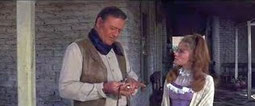
In September 1969, Batjac’s executive producer Michael Wayne had laid the cornerstone of a new $1.6 million filming complex, financed by the state of Durango, where shooting was set to take place. Thirty-five miles from Durango, a complete ranch complex was erected, on the grounds of the Rancho Marley.

They even planted the single tree where Chisum surveys his cattle empire.

The same spread, sometimes just called the “Durango Ranch”, also became “the great McCandles ranch" in Big Jake in the following year.

Chisum rides to town the same road that...

...Richard Boone's gang comes up to raid the McCandles ranch.

In 1970, Howard Hawks had to find the location for a Civil War-era steam train and period railway station, with tracks that ran through a forest of trees. They found the location a short distance from Cuernavaca. During his stay in Cuernavaca, Wayne learned about the „Our Little Brothers and sisters“ orphanage and became one of their principal benefactors.
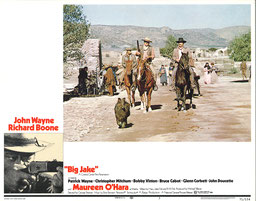
He was back in Durango for Big Jake. The furious firefight at the end of the picture was filmed in the famous arched courtyard of Don Luis Flores in Durango, one of the remnants of the old Mexico.

Burt Kennedy had picked Torreón, three hours outside Durango, for the desert locations of The Train Robbers, filmed March 23 to mid-June 1972. It was art director Alfred Sweeney‘s idea to put an abandoned train on the sand-dunes.

The fictional settlement called Liberty was built north of Durango. The town that was subsequently destroyed to film the story's climax cost $100,000 to construct.

Once more, the film used the triple El Saltito waterfall east of Durango, in the municipality of Sombrerete.
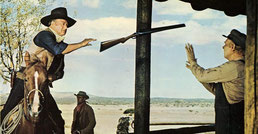
Batjac built yet another western street for the 1972 production of Cahill, U.S. Marshal. North out of Durango, about twenty miles along the way, was La Joya. 250 artisans worked for twenty-six weeks to convert the little Mexican town of La Joya into a western town and make the houses look a century old. Cahill U.S. Marshal became John Wayne’s final Mexico movie. After his last visit in Durango, future movie projects for the La Joya locale faded.
©All text content on this website is protected by copyright and other intellectual property laws. No part may be reproduced without the prior written permission. All photos courtesy of Roland Schaefli, unless otherwise stated.
This website is in no way associated with the John Wayne Estate or business enterprises. Go to johnwayne.com to find the official website and to https://johnwayne.org/ to read about the wonderful John Wayne Cancer Foundation.
more john wayne locations to scout
If you like this site, you'll like the book: the first comprehensive guide to the John Wayne Locations, with hundreds of then-and-now photos, unpublished behind-the-scenes-pictures and detailed tour descriptions
Tracking John Wayne: The complete Tourguide
Find directions to locations and anecdotes from the Duke's movie sets in this new publication from McFarland, available at bookstores and online shops
For all locations mentioned on this website, the book offers behind-the-scenes stories, making-of anecdotes and never before published photos

